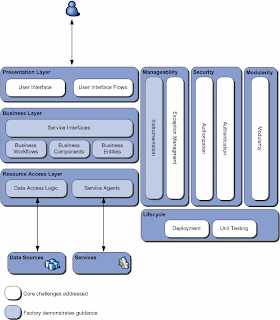
Web Client Software Factory - Release June 2007
Architects and developers can use the Web Client Software Factory to quickly incorporate many of the proven practices and patterns of building Web client applications. These practices and patterns have been identified during the development of many Web client applications and their components.
By using the software factory, architects and developers can focus their efforts on business opportunities and create Web applications that effectively address the needs of their organizations.
The Web Client Software Factory provides an integrated set of guidance that assists architects and developers in creating composite Web applications and page flow client applications.
These applications have one or more of the following characteristics:
- They have complex page flows and workflows.
- They are developed by multiple collaborating development teams.
- They are composite applications that present information from multiple sources through an integrated user interface.
- They support XCopy deployment of independently developed modules.
- They support online business transaction processing Web sites.
This software factory provides proven solutions to common challenges found while building and operating large transaction processing enterprise Web sites. It helps architects and developers build modular systems that can be built by independent teams, design complex screen workflows, improved security and testability.
Applications built with the software factory use proven practices for operations like centralized exception logging and can be XCopy deployed.
The software factory contains a collection of reusable components and libraries, Visual Studio 2005 solution templates, wizards and extensions, How-to topics, automated tests, extensive architecture documentation, patterns, and a reference implementation. The software factory uses ASP.NET, Windows Workflow Foundation, and the Enterprise Library–January 2006.
Software Factory Contents
The Web Client Software Factory is an integrated collection of tailored software assets that support composite Web application development. The collection includes the following:
Application blocks and libraries. The Composite Web Application Block, Page Flow Application Block, ObjectContainerDataSourceControl control are included in the software factory. The software factory also uses Enterprise Library application blocks for security, exception management, logging, and data access.
Recipes. The software factory includes the Add View (with presenter) recipe and Add Page Flow recipe. Recipes automate procedures in How-to topics, either entirely or selected steps. They help developers complete routine tasks with minimal input.
Templates. The software factory includes the Solution template, Business Module template, Foundational Module template, and Page Flow template. Templates are prefabricated application elements with placeholders for concrete arguments. They can be used for many purposes, including creating initial solution structures to creating individual solution artifacts, such as project items.
Designers. The software factory includes the page flow designer. Designers provide information that architects and developers can use to model applications at a higher level of abstraction. Designers can also generate code that is compatible with the architecture baseline.
Reference implementation. The software factory includes the Global Bank Corporate e-Banking reference implementation. A reference implementation provides an example of a realistic, finished product that the software factory helps developers build.
Architecture guidance and patterns. The software factory includes architecture guidance and patterns that help explain application design choices and the motivation for those choices.
How-to topics. The software factory includes How-to topics; these are documented step-by-step instructions that describe how to implement recommended practices in a specific domain.
No comments:
Post a Comment